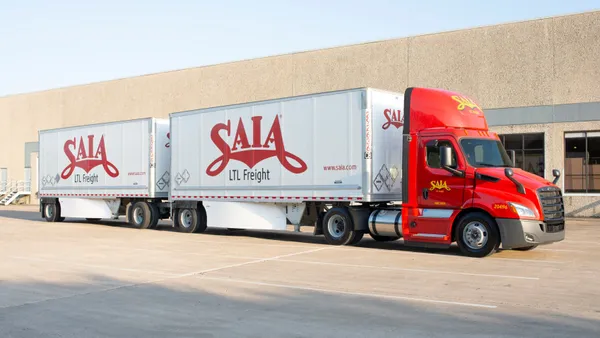Editor's Note: This story is part of a weekly analysis of the logistics industry's latest statistics. See an overview in our data hub.
Dive Brief:
- Air freight demand surged again in May, signaling the transport sector's growth is far from over, although the International Air Transport Association (IATA) warns the "best of the cyclical upturn may have passed."
- The IATA May 2017 Air Freight Market Analysis found global freight ton kilometers (FTKs) grew by 12.7% in May compared to the previous year, or three-times the five-year average growth rate, and more than two times the growth seen in April.
- The IATA argues the surge matches an improvement in global trade, driven by European, Asian and North American markets. However, the analysis finds the first-half of 2017 benefited from a global push to restock inventory — a push that may be ending, per recent growth in global inventory-to-sales ratios.
Dive Insight:
A few setbacks aside, the first-half of 2017 has seen remarkably high growth rates, both in year-over-year and in seasonally-adjusted terms.
While the IATA argues this growth should be nearing its end, given rising inventories — as well as subsequently declining rush-for-orders, which air cargo thrives on — recent events suggest demand for air cargo will continue to significantly outpace supply throughout the summer, as disruptions in the ocean industry continue to impact supply chains.
It's no secret that air cargo demand is deeply tied to the reliability of ocean cargo. Supply chain managers typically build in some buffers into their lead times, but as cost-saving initiatives continue to encourage low inventories, the risk of logistics-based disruption increases. Port strikes, congestion, crippling cyberattacks and shifts in service routes over the past few months likely led many shippers to find alternative means of transportation. In these cases, air cargo exists to save the day.
Yet, the question remains: How much new demand can the air freight industry retain going into peak shipping season? If high growth is truly due to seemingly isolated disruptions, as ocean shippers self-correct and reinforce reliability, shippers will continue to prefer lower prices. Similarly, are tighter fulfillment timelines — tied to trends including fast-fashion, shorter design-to-market cycles and e-commerce — worth the increased cost of air freight in the long-run?
The transition to e-commerce seems to benefit air cargo as supply chains adapt to these new trends, and carriers are similarly adapting to service these needs. However, the industry is clearly hedging its bets against high sustained growth, considering the slow investment in increased capacity. Rates, in turn, will remain high or increase.
For now, as demand continues to rise, the industry seems to prefer inflated rates, which allow them to invest in business expansions including international alliances, freighter-belly partnerships and cold chain airport capacity. Once demand subsides, airlines can release new services to attract a more diverse customer base.













